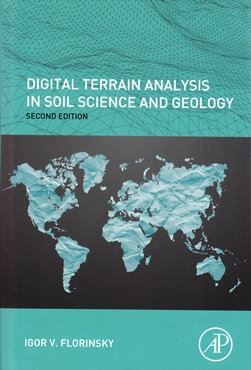
This book would be useful for anyone with an interest in Digital Terrain Analysis, including soil scientists, geologists, geoscientists, geomorphologists, geographers, and GIS scientists.
The book is aimed at either postgraduate or lecturer level, and assumes a level of mathematics. However, the mathematical approach is accessible, being focused mainly on the derivatives of surfaces (1st to 3rd order), vectors and trigonometry. It is compatible with current approaches of surface analysis generally adopted to date within GIS.
The book is divided into 3 sections. Section one, which comprises over half of the book deals mostly with a mathematical exploration of the analysis methods of describing shape before exploring effects of gridding, errors and filtering of elevation data. Chapter 8 provides useful information and thoughts on the visualization of data.
This section of the book is well written with clear explanations of the concepts, which together with examples provides a sound basis for the underlying principles of terrain surface analysis and the key parameters for such analysis. Tables 2.1 and 2.2 are particularly useful in this respect.
As a word of caution, this is not a book on spatial statistics and does not deal with statistical methods of spatial analysis. The reader would need to consult a separate textbook on these subjects.
Sections two and three provide several examples of the use of DTM in the fields of soil science and geology, with an emphasis on soil science.
The geological examples are related to the location and interpretation of folding and faulting, lineaments, and larger scale global tectonic structures. O’Driscoll’s double helix example used to demonstrate global tectonics has found increasing interest in the past few years in the field of exploration geology and is a worthwhile reminder of this concept.
References are kept to the back of the book rather than after each chapter. Unsurprisingly, many of these are in Russian or are Russian in origin. While reference to some expected literature references on this subject are missing, the range of less well-known references is of interest.
As the preface to this book states, there has been a proliferation in the accessibility and use of different GIS programmes lately. This means that an understanding of their use and output is becoming increasingly important and relevant.
This book offers a good introduction to terrain analysis and I would recommend it to anyone requiring a sound introduction to this subject.
Reviewed by Rod Smith
DIGITAL TERRAIN ANALYSIS IN SOIL SCIENCE AND GEOLOGY (2nd edn) by IGOR FLORINSKY. Elsevier 2016. (hbk) 4506pp.eBook ISBN: 9780123850379 Hardcover ISBN: 9780123850362 List Price for bundle: $210.00 + tax. W: www.elsevier.com/books/digital-terrain-analysis-in-soil-science-and-geology/florinsky/978-0-12-804632-6
Save